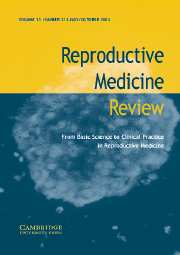No CrossRef data available.
Article contents
Preimplantation genetic diagnosis
Published online by Cambridge University Press: 10 July 2002
Abstract
The aim of preimplantation genetic diagnosis (PGD) is to give couples at risk of passing on a genetic disorder an alternative to standard prenatal diagnosis by enabling them to start a pregnancy that is known to be free of the familial disease. This can be achieved by generating embryos in vitro by standard in vitro fertilization (IVF) techniques and then removing one to two of the cells from the early embryo (embryo biopsy). Single cell polymerase chain reaction (PCR) or fluorescence in situ hybridization (FISH) can then be used to diagnose single gene defects or chromosomal abnormalities respectively. Those embryos diagnosed as free from disease can then be considered for transfer to the womb and so the pregnancy is started knowing that the fetus is unaffected. This avoids the need to consider pregnancy termination in the quest for a healthy child. Originally it was thought that the major reason for referral would be the risk of passing on a single abnormal gene but an increasing proportion of couples are requesting PGD because of recurrent miscarriage due to parental chromosomal abnormality.
- Type
- Research Article
- Information
- Copyright
- © 2002 Cambridge University Press


